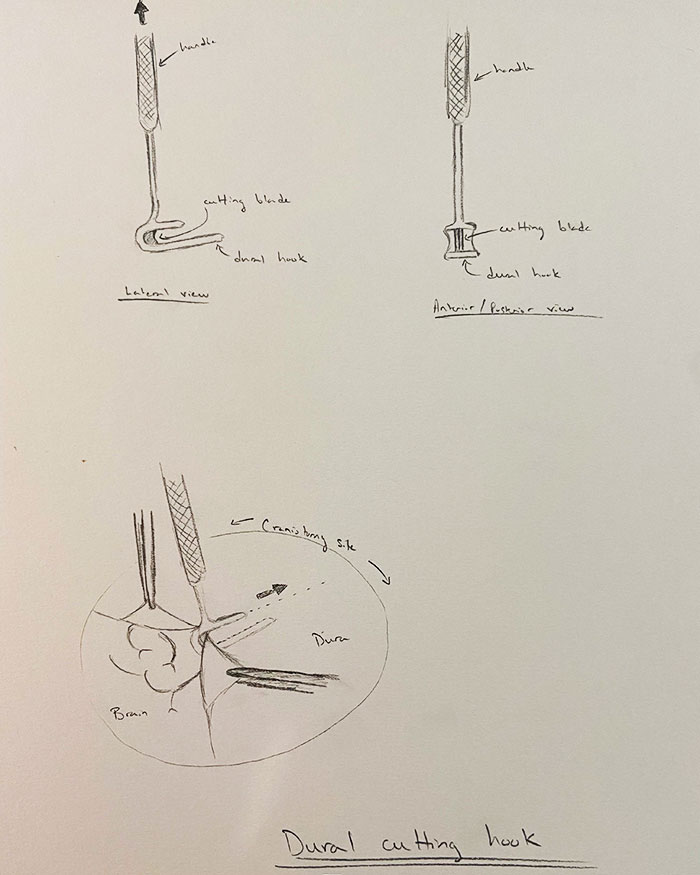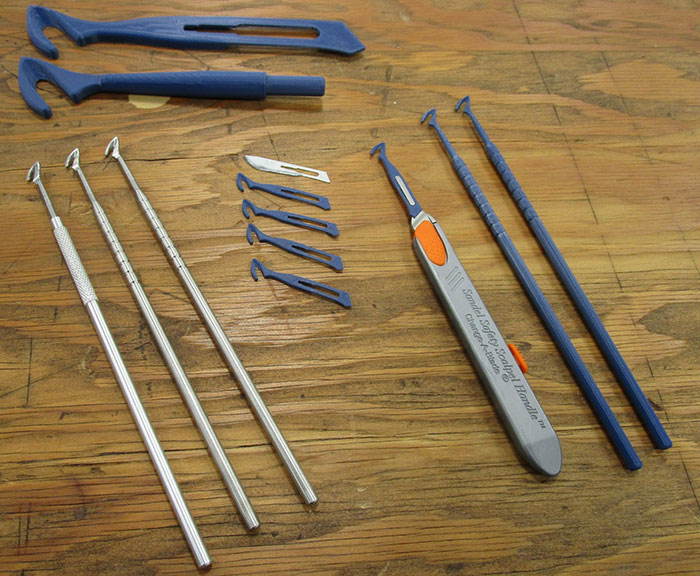New Tool Will Help Neurosurgeons Perform Delicate Cutting Task

FORT DETRICK, Md. – A new surgical instrument being developed with support from the U.S. Army Medical Research and Development Command was inspired by a tool commonly used by first responders to help free accident victims trapped in their cars.
The Delta Hook™, invented by Dr. Alexander Villahermosa, an Army neurosurgery resident at the University of Texas Health Science Center at San Antonio, is a handheld cutting tool that will make it easier for doctors to slice open the thin membrane lining the brain, called the dura, when performing neurosurgery. Villahermosa says the design was based on the rescue hooks that he and other Army medics carried with them on operations.
"We carried rescue hooks in our aid bags and used them instead of trauma shears to quickly 'unzip' the clothing of an injured person," says Villahermosa. "Later, when I was on rotation at the Walter Reed National Military Medical Center, I saw how neurosurgeons would use a knife to make a small incision in the dura and then use a thin spatula to lift the dura from the brain and a knife or scissors to cut it. The procedure is delicate, it usually requires two people and you have to be mindful not to let the cutter slip. I thought, 'Wouldn't it be really cool if there was a small rescue hook that you could use to unzip the dura instead?'"
Villahermosa didn't give the idea much thought at the time, but the more brain surgeries he performed – particularly on trauma patients whose brains were swollen, reducing the space available to insert a tool underneath the dura – the more the idea would pop back into his head. Finally, one day on vacation, he found himself thinking about the idea and he decided to sketch what such a tool could look like.
"Every once in a while I'll have an idea and I'll sketch it out," says Villahermosa. "A lot of things don't make it out of the sketchbook. But with this one, I wondered if I could make it happen."
Villahermosa showed his sketch to a neurosurgeon mentor who agreed that such a tool could be useful for simplifying the dura cutting process and encouraged him to pursue it further. Villahermosa next approached MRDC's Medical Technology Transfer Office, which works with DOD inventors to help them successfully commercialize their products for the Warfighter. MTT uses an award-winning process it developed called Assistive Technology Transfer, or AT2, to systematically mature and de-risk new biomedical technologies until they are ready to be licensed by commercial partners.
Ron Marchessault, a technology transfer professional with MTT, helped Villahermosa apply for a provisional patent for his design. He also helped Villahermosa to apply for a trademark for the name Delta Hook™, in honor of U.S. Army Special Forces medical sergeants, also known as 18 Deltas, the source of his inspiration for the invention.
"I went through the patent application process on my own some years ago," says Villahermosa. "It's very time consuming and costly, and I didn't know what I was doing. Had I known that this kind of assistance was available, I definitely would have reached out for help!"

Marchessault reached out to MRDC's Medical Materiel Development Activity for assistance turning Villahermosa's sketches into prototypes that could be evaluated for their ergonomics and functionality. MTT has an interagency agreement with USAMMDA that provides access to its Medical Prototype Development Lab to provide design, fabrication, evaluation and testing services for invention prototypes. In consultation with Villahermosa, the lab team fabricated metal and plastic models in a variety of reusable, disposable and replaceable configurations.
"I was talking to one of the fabricators in the lab about the design, detailing some of my thoughts about how it would work, and he said, 'This is like a rescue hook!'" recalls Villahermosa. "He saw where the concept came from and what I was trying to do with it. That was reassuring. I thought, 'Okay, he gets it!'"
In addition to helping Villahermosa work out the finer points of the design, the prototypes serve another useful purpose: Marchessault can display them at tech showcases, professional conferences and other events attended by potential commercial partners interested in acquiring the rights to manufacture and sell promising new medical products.
To further generate interest in the Delta Hook™, Marchessault also reached out to one of its partners, TechLink, a nonprofit organization in Montana State University's Office of Research and Economic Development that specializes in finding commercial licensees for new products developed by MTT and others. TechLink will add the Delta Hook™ to its online searchable database of available products, and it will also research companies that might be interested in acquiring a license and reach out to them to gauge their interest.
"The Delta Hook™ is a very promising device," says Marchessault. "It could be manufactured in a number of different ways. The blade itself could be disposable and the handle could be a durable item, for example. And it has the potential for use in other medical applications beyond brain surgery. Surgeons could use it in general or trauma surgery to open the fascial layer on muscle tissue."
While MTT and TechLink work on generating interest in the Delta Hook™, Villahermosa has been able to turn his attention back to completing his surgical residency, which demands most of his time and energy right now.
"I'm grateful for MTT's and USAMMDA's help," says Villahermosa. "This has been a learning process and if the Delta Hook™ has potential, I really want it to be done the right way. I've been in the Army for 22 years now and the Army has invested in me. I've earned my college degree and gone to medical school through the Army, and I am grateful for that. If I can give back in some way with this invention, I'm glad to do it."














